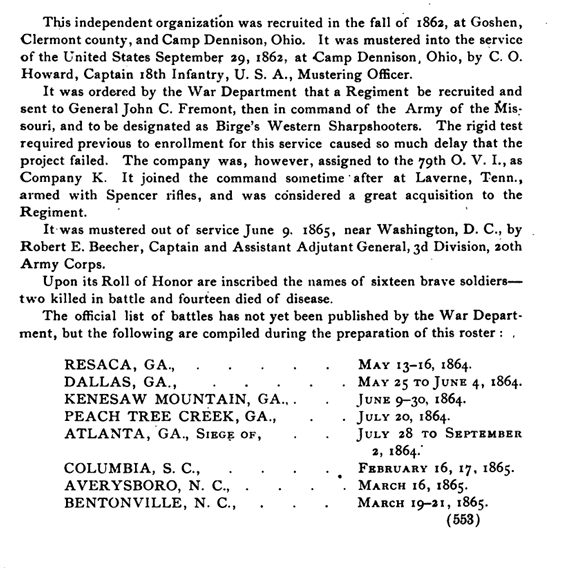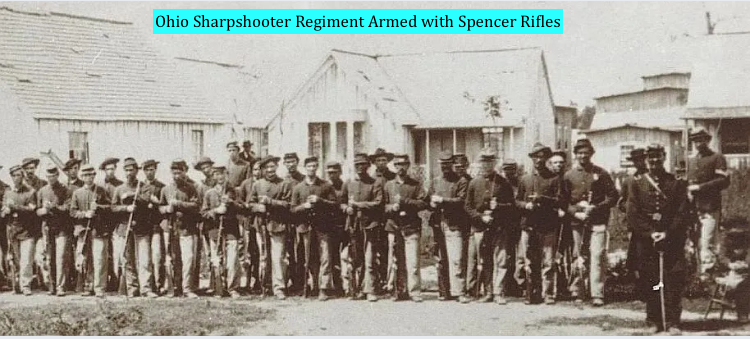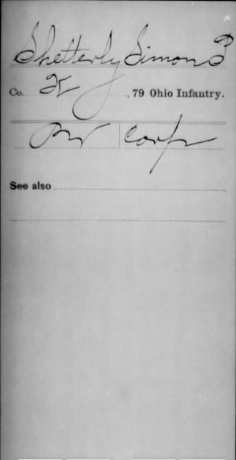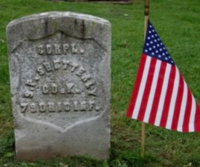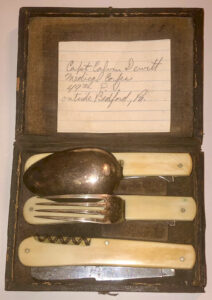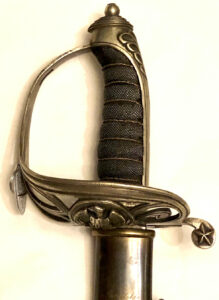Id’d Civil War Whiskey Flask Carried by Private Simon P. Shetterly Ohio 4th Independent Company Sharpshooters
$475
Id’d Civil War Whiskey Flask Carried by Private Simon P. Shetterly Ohio 4th Independent Company Sharpshooters – Civil War period, glass flask, covered in light weight, woven wicker or “straw”, with a piece of period, old paper, exhibiting a hand-inked note, affixed to the exterior of the flask that states the following:
“Whiskey flask covered with
straw by Simon Shetterly”
Simon P. Shetterly enlisted in August, 1862, into the 4th Independent Ohio Sharpshooters, at the initial rank of Private. Shetterly would be promoted to the rank of Corporal, in April, 1863. Shetterly and other members of the 4th Ohio Sharpshooters, would be attached to Co. K, 79th Ohio Infantry, in September, 1862. The 4th Ohio Sharpshooters, had been issued Spencer rifles, so they were quite a welcome addition to the 79th Ohio Infantry. Shetterly remained with the 79th Ohio, until the end of the war. With the 79th, Shetterly and his comrades would see action during the Atlanta Campaign at New Hope Church, Resaca and Peach Tree Creek; they would also be engaged at the Battle of Bentonville, NC and assist in the overseeing of the surrender of Confederate forces under Gen. Joe Johnston, later participating in the Grand Review and mustering out in June, 1865. Shetterly survived the war, only to be killed in a tragic accident, falling from scaffolding in 1877, in Anderson, Ohio.
The flask remains in fine condition and is typical of war period flasks we have had, many of which were covered in woven wicker or straw; on the sides of the flask, two woven loops remain as modes for attaching a carrying strap.
Measurements: H – 7”; W (widest section) – 4.5”
Simon P. Shetterly
| Residence was not listed; 25 years old.
Enlisted on 8/20/1862 as a Private. On 9/29/1862 he mustered into “4th Indpt” Co. OH Sharpshooters He was Mustered Out on 6/14/1865 Promotions: * Corpl 4/2/1863 |
Simon P. Shetterly
| Residence was not listed; 25 years old.
Enlisted on 8/20/1862 as a Private. On 9/29/1862 he mustered into “K” Co. OH 79th Infantry He was Mustered Out on 6/9/1865 at Camp Dennison, OH Promotions: * Corpl 4/2/1863
HISTORY OF MADISON COUNTY INDIANA page 562 One of the most horrible occurrences that ever took Place in Anderson was the falling off of a scaffold from Louis Lobe’s building on the south side of the public square, in February 1877, by Geo. Brown and Simon P. Shetterly. They were painting the front of the building, using a swinging scaffold. They were standing close together at work when it became necessary for them to move their position. Shetterly sat down, or squatted rather on his feet for the purpose of allowing Brown to pass around him. Brown was in the act of passing Shetterly, and had thrown one leg on the opposite side and was just in the act of bringing the other around which would have made his passage safe, when the scaffold shook, or from some other cause frightened Shetterly, when he jumped and straightened up throwing Brown backward. Brown in attempting to save himself, caught Shetterly, and in less than an instant they lay upon the stone sidewalk a shapeless mass of broken bones and bruised flesh. Shetterly was almost instantly killed. Brown was so terribly mangled that every one thought it was a pity that he was not killed outright. Shetterly’s body was conveyed to his home on Nichol Avenue, from whence he was in due time buried. Brown was taken to his mother’s residence in the south part of town, where Dr. N. L. Wickersham was called and attended to his wounds. There was scarcely a bone in his body that was not broken. His legs, his arm, his jawbone, and in fact he was all broken up. Everyone thought it would be a blessing if death would relieve him, as he would certainly be an awful cripple if he survived. But Dr. Wickersham never let go of George. He stayed with him like a twin brother and patched him up; set his broken bones, bound up his wounds, and while he did not exactly make a new man of him, one would hardly think to see George Brown, the painter and paper hanger, on the streets of Anderson, that he had been run through a threshing machine in his life time. George gets around about as nicely as any one, and is a prosperous and happy man; does as much work as any man in town, and enjoys life as well as the best of them. He has been as near deaths door as any man ever was to get back. Poor Simon Shetterly never knew what caused his death. He was never conscious after landing on the stone pavement. He was not so terribly mangled as Brown, but was in some way killed in the fall. He left a widow and a small family of children, who yet live on Nichol Avenue, in comfortable circumstances. Simon was one of the first members of the Knights of Honor, and held a policy of $2,000 in that organization, which his family received at his death. He was a Spiritualist in belief, and his immediate friends and relatives claim that he often comes back to his old home and associations. Simon Shetterly was an honest, upright man, as industrious as the busy bee, never gave any one a crusty answer or angry word, and was a man universally liked by all who knew him. The fall from the scaffold was witnessed by several people who were standing near by, but every one was so horrified that they turned their backs and held their breaths until the heavy thud announced the landing on the pavement. So dumbfounded were they that it was some time before a person moved or came to the relief of the unfortunates. This is one of the occurrences that will never be erased from the memory of the Anderson old-timers, and it is hoped that it will never be repeated. Regimental History Fourth Independent Company Sharpshooters. – Capts., Jacob Flegle, Robert C. Williamson; First Lieuts., Isaiah Daughman, Henry C. Corbin, William P. Juday. This independent organization was recruited in the fall of 1862, at Goshen, Clermont county, and Camp Dennison, where it was mustered into the U. S. service on Sept. 29. It was ordered by the war department that a regiment be recruited and sent to Gen. John C. Fremont, then in command of the Army of the Missouri, and to be designated as Birge’s western sharpshooters. The rigid test required previous to enrollment for this service caused so much delay that the project failed. The company was, however, assigned to the 79th Ohio infantry as Co. K. It joined the command sometime after at La Vergne, Tenn., armed with Spencer rifles and was considered a great acquisition to the regiment. It was mustered out on June 9, 1865, near Washington, D. C. Upon its roll of honor are inscribed the names of 16 brave soldiers – 2 killed in battle and 14 died of disease. InscriptionCO K 79 Ohio Inf
|
OHIO
FOURTH INDEPENDENT COMPANY SHARPSHOOTERS
(SEVENTY-NINTH INFANTRY COMPANY “K”)
(Three Years)
| Fourth Independent Company Sharpshooters. – Capts., Jacob
Flegle, Robert C. Williamson; First Lieuts., Isaiah Daughman, Henry C. Corbin, William P. Juday. This independent organiza- tion was recruited in the fall of 1862, at Goshen, Clermont county, and Camp Dennison, where it was mustered into the U. S. service on Sept. 29. It was ordered by the war department that a regiment be recruited and sent to Gen. John C. Fremont, then in command of the Army of the Missouri, and to be designated as Birge’s western sharpshooters. The rigid test required previ- ous to enrollment for this service caused so much delay that the project failed. The company was, however, assigned to the 79th Ohio infantry as Co. K. It joined the command sometime after at La Vergne, Tenn., armed with Spencer rifles and was considered a great acquisition to the regiment. It was mus- tered out on June 9, 1865, near Washington, D. C. Upon its roll of honor are inscribed the names of 16 brave soldiers – 2 killed in battle and 14 died of disease. |
79th OH Infantry
( 3-years )
| Organized: Camp Dennison, OH on 8/1/62 Mustered Out: 6/9/65 at Washington, DC Officers Killed or Mortally Wounded: 0 |
| From | To | Brigade | Division | Corps | Army | Comment |
| Sep ’62 | Nov ’62 | Ward’s | Army of Ohio | |||
| Nov ’62 | Jun ’63 | Ward’s | Post of Gallatin, TN | Army of Cumberland | ||
| Jun ’63 | Oct ’63 | 2 | 3 | Reserve | Dept and Army of Ohio and Cumberland | |
| Oct ’63 | Jan ’64 | Ward’s | Post Nashville | District Nashville | Military Division of the Mississippi | |
| Jan ’64 | Apr ’64 | 1 | 1 | 11 | Dept and Army of Ohio and Cumberland | |
| Apr ’64 | Jun ’65 | 1 | 3 | 20 | Dept and Army of Ohio and Cumberland | Mustered Out |
OHIO
SEVENTY-NINTH INFANTRY
(Three Years)
|
Seventy-ninth Infantry. – Col., Henry G. Kennett; Lieut.- Col., Azariah W. Doane; Majs., Henry S. Clements, William W. Wilson, Samuel A. West. This regiment was organized at Camp Dennison from Aug. 20 to Oct. 21, 1862, to serve for three years. It crossed the Ohio river at Cincinnati, that city being menaced by the Confederate army concentrated at Lexing- ton. It performed guard duty and other detailed work in Ken- tucky and Tennessee until the spring of 1864, when it joined in the campaign against Atlanta. The regiment was not engaged in the demonstrations at Buzzard Roost and Dug gap, being in the reserve line, but after passing through Snake Creek gap, near Resaca, it skirmished with the enemy, with considerable loss in killed and wounded. In the assault on Kennesaw mountain the regiment was in the charging party and it lost several men. At Peachtree creek it was in the front line, being the second regiment engaged, and in the battle lost one-half its men. Af- ter this battle and until the evacuation of Atlanta, when the regiment received recruits, it was only a regiment in name, not in numbers. It commenced the campaign with 600 men and at its close had 182. Fifteen recruits were received during the cam- paign, of whom 7 were lost, thus making the loss 425 men in about 100 days. It was in the march to the sea and the cam- paign of the Carolinas, taking part in the affairs at Columbia, Averasboro and Bentonville. At Columbia the loss was small, not exceeding 30 men killed, wounded and prisoners. At Averas- boro it took an active part, assaulting and carrying that part of the enemy’s lines where his artillery was posted. It cap- tured 3 pieces of artillery, 100 stands of small arms and 31 prisoners. For this charge the regiment received many encomi- ums, but its loss in killed and wounded was severe, being one- fourth of the number engaged. About May 1, it turned homeward by way of Richmond and was mustered out at Washington on June 9, 1865. Its loss, from all causes, was about 1,000 men – more than its original number. |
4th Ohio Independent Company Sharpshooters
in the American Civil War
|
4th Ohio Company Sharpshooters Soldier Roster – Official Roster of the Soldiers of the State of Ohio in
the War of the Rebellion, 1861-1866, Volume 1, by Ohio Roster Commission (Wm. McKinley, Jr., Governor, Samuel M. Taylor, Sec’y of State and James C. Howe, Adjutant-General), 1893 Lieuts., Isaiah Daughman, Henry C. Corbin, William P. Juday. This independent organization was recruited in the fall of 1862, at Goshen, Clermont county, and Camp Dennison, where it was mustered into the U. S. service on Sept. 29. It was ordered by the war department that a regiment be recruited and sent to Gen. John C. Fremont, then in command of the Army of the Missouri, and to be designated as Birge’s western sharpshooters. The rigid test required previous to enrollment for this service caused so much delay that the project failed. The company was, however, assigned to the 79th Ohio infantry as Co. K. It joined the command sometime after at La Vergne Tenn., armed with Spencer rifles and was considered a great acquisition to the regiment. It was mustered out on June 9, 1865, near Washington, D. C. Upon its roll of honor are inscribed the names of 16 brave soldiers — 2 killed in battle and 14 died of disease. |
4th Ohio Independent Company Sharpshooters
Flegle’s Sharpshooters
compiled by Larry Stevens
References for this Unit
- Ohio In The War-Volume II. Whitelaw Reid. Moore, Wilstach & Baldwin. Cincinnati. 1868
- Dear Child: The Civil War Letters of Eleazer Gorham and Selected Stories of the Fourth Independent Company Ohio Volunteer Sharpshooters (Company K, Seventy-Ninth Ohio Volunteer Infantry Regiment). Eleazer Gorham. Edited by Darryl Smith. 35 pgs. Paperback. Footnotes. Various newspaper articles. Published by Darryl Smith. Cincinnati. Ohio. 2021
History
Ten Independent Companies of Sharpshooters were recruited and partly organized at different periods during the war; all became parts of regiments in the field, and no distinct organization was affected from them. Three full companies were assigned to other states, Company G, organized at Dayton, to the Fourteenth Missouri; Company H, organized at Findlay, and Company K, at Lima, to the Sixty-Sixth Illinois; later, by special request, Company G was transferred to the same Regiment. The three Companies re-enlisted in December, 1863, and later took part in the Atlanta campaign, Sixteenth Corps, Army of the Tennessee.
79th Regiment, Ohio Infantry
OVERVIEW:
Organized at Camp Dennison, Ohio, August, 1862. Ordered to Kentucky September 3, 1862. Advance to Crittenden, Ky., September 7, thence moved to Louisville, Ky. Attached to Ward’s Brigade, 12th Division, Army of the Ohio, to November, 1862. Ward’s Brigade, Post of Gallatin, Tenn., Dept. of the Cumberland, to June, 1863. 2nd Brigade, 3rd Division, Reserve Corps, Army of the Cumberland, to August, 1863. Ward’s Brigade, Nashville, Tenn., Dept. of the Cumberland, to January, 1864. 1st Brigade, 1st Division, 11th Army Corps, Army of the Cumberland, to April, 1864. 1st Brigade, 3rd Division, 20th Army Corps, Army of the Cumberland, to June, 1865.
SERVICE:
March to Frankfort, Ky., October 3-9, 1862. Occupation of Frankfort October 9, and duty there till October 26. Expedition to Lawrenceburg in pursuit of Morgan October 10-13. March to Bowling Green, Ky., October 26-November 4, thence to Scottsville and to Gallatin November 25, and duty there till December 11. Moved to South Tunnel December 11, and duty there till February 1, 1863. Duty at Gallatin till June 1. Moved to Lavergne June 1, thence to Murfreesboro, Tenn., July 2, and to Lavergne July 29. To Nashville, Tenn., August 19, and duty there till February 24, 1864. March to Wauhatchie Valley, Tenn., February 24-March 10, and duty there till May 2. Atlanta (Ga.) Campaign May 2-September 3. Demonstration on Rocky Faced Ridge May 8-11. Battle of Resaca May 14-15. Cassville May 19. Advance on Dallas May 22-25. New Hope Church May 25. Operations on line of Pumpkin Vine Creek and battles about Dallas, New Hope Church and Allatoona Hills May 25-June 5. Operations about Marietta and against Kenesaw Mountain June 10-July 2. Pine Hall June 11-14. Lost Mountain June 15-17. Golgotha or Gilgal Church June 15. Muddy Creek June 17. Noyes Creek June 19. Kolb’s Farm June 22. Assault on Kenesaw June 27. Ruff’s Station July 4. Chattahoochoe River July 5-17. Peach Tree Creek July 19-20. Siege of Atlanta July 22-August 25. Operations at Chattahoochie River Bridge August 26-September 2. Occupation of Atlanta September 2-November 15. March to the sea November 15-December 10. Siege of Savannah December 10-21. Campaign of the Carolinas January to April, 1865. Occupation of Robertsville, S. C., January 30. Lawtonville February 2. Taylor’s Hole Creek, Averysboro, N. C., March 16. Battle of Bentonville March 19-21. Occupation of Goldsboro March 24. Advance on Raleigh April 10-14. Occupation of Raleigh April 14. Bennett’s House April 26. Surrender of Johnston and his army. March to Washington, D. C., via Richmond, Va., April 29-May 20. Grand Review May 24. Mustered out June 9, 1865.
Regiment lost during service 54 Enlisted men killed and mortally wounded and 1 Officer and 91 Enlisted men by disease. Total 146.
Predecessor Unit
OHIO VOLUNTEERS
4th INDEPENDENT COMPANY SHARPSHOOTERS.
Organized at Goshen and Camp Dennison, Ohio, and mustered in September 29, 1862. Attached to 79th Ohio Infantry as Company “K.”
Simon Shetterly 4th Independent Ohio Sharpshooters
Almost 330,000 Ohio men, including 5,092 African Americans, served in the Union military during the conflict. Sharpshooter units formed in Ohio became known as regiments of Ohio Volunteer Sharpshooters. In September and October 1861, Ohio officials authorized the creation of ten companies of sharpshooters.
An Ohio Sharpshooters Letter – A Wedding at Stones River
Not much is heard about the various companies of Ohio sharpshooters that were raised during the Civil War. Ten independent companies were formed in Ohio throughout the course of the conflict, but how they were used in their sharpshooting role is rarely mentioned in accounts of battles and skirmishes. Three of these companies were assigned to the 66th Illinois, which had been Birge’s Western Sharpshooters earlier in the war, Birge’s regiment being one of the more noted Federal sharpshooter units in the Western Theater. The other independent companies of Ohio sharpshooters were normally assigned to various Ohio infantry regiments, but at times were also formed into ad hoc battalions.
In September 1862, the Fourth Ohio Independent Company Sharpshooters, also known as Flegle’s Sharpshooters, were formed, mustering into service on the 29th of that month at Camp Dennison near Cincinnati (158 years ago to the day this post was published on the site). They were to be also assigned to Birge’s unit, but due to their rigid method for recruiting skilled riflemen organizing the company was delayed. Their first captain was Jacob Flegle, a 43 year old from Clermont County. Like many other companies raised during the war there were several brothers and cousins within the ranks, but unlike many companies the men were an older lot, with the average of the men of the Fourth being twenty-seven years of age. There were several men in their 30s and 40s within the company. The company was later assigned as Company K of the Seventy-Ninth Ohio Volunteer Infantry. Indeed of those men whose graves I have visited who have veteran gravestones indicates they were a member of Company K of the Seventy-Ninth and nothing about their service in the Fourth.
In the autumn of 1862 Gov. Tod undertook to raise ten independent companies of sharpshooters, to serve on special duty, without field officers. Capt. Gershom M. Barber raised a company which was largely composed of residents of Cuyahoga county, and which was designated the Fifth Independent Company of Sharpshooters. The Sixth and Seventh companies were also recruited in this county; the captains having free access to the large camp of drafted men at Camp Cleveland. A portion of their men were actual resident of the county, though generally credited to other counties in which the captains resided. The Ninth and Tenth companies were also largely composed of Cuyahoga-county men, but, as previously stated these were mustered into the Sixteenth Infantry and served with that regiment.
On the companies being completed, the Fifth, Sixth and Seventh were organized in a battalion, and Capt. Barber, as the senior officer, was placed in command. The men were all picked with reference to their physical ability, and before being mustered each was required to make a “string” of not exceeding twenty-five inches in five shots, at one hundred yards off-hand or at two hundred yards at a rest. Their uniform was the same as that of the infantry, except that the trimmings were green, and they were armed with Spencer’s seven-shooting rifles.
They remained at Camp Cleveland, drilling as infantry and also practicing at the target, until March, 1863, when they joined Rosecrans’ army at Murfreesboro, and were attached to the general’s headquarters for special service. The battalion was never brigaded, but remained permanently attached to the headquarters of the Army of the Cumberland throughout the war; being detailed on special duty whenever necessary. The battalion was there joined by the Fourth and Eighth Independent companies; the whole being under the command of Capt. Barber. The Fourth company, however, was detached just before the battle of Chickamauga.
At the battle two companies, of which the Fifth was one, were in charge of the department headquarters. On Sunday, the third day of the fight, while they were on their way, under orders, to join Gen Rosecrans, and while in rear of Gen. Jefferson C. Davis’ division, there was a general break along the Union lines, and that division retreated; leaving the sharpshooters directly in front of the enemy. Unable to join Rosecrans, Capt Barber reported to Davis who ordered him to fall back four hundred yards and form line of battle. He did so, and Davis attempted to rally his division in the rear. It broke, however, and a similar order was again sent to Capt. Barber and obeyed. Four times the sharpshooters formed in line and engaged the enemy’s advance; thus covering the retreat of Davis’ division, and at length following it from the field.
When, after that battle, the rebels cut off the supplies from the army at Chattanooga, Gen. Rosecrans had a road built westward along the north side of the Tennessee. But the rebel sharpshooters from across the river, at the point where it passes through the Cumberland mountains, broke up the first supply train; killing many of the men and horses. A regiment of Kentucky infantry and a battery of artillery both proved unable to protect the exposed point. Capt. Barber was then ordered to detail fifty men for that purpose. He obtained permission to go in command himself.
Taking his detail to the locality on the rainy afternoon of the 13th of October, 1863, he went over the exposed road, attended only by a guide, to lay out his plans. Nearly a hundred shots were fired across the river at the two men, but by keeping on the move they escaped injury. Having thus ascertained just where the enemy was posted, the captain at three o’clock the next morning let his men on to the ground, and stationed them in squads opposite the positions occupied by the rebels.
At dawn both parties began firing across the river. A series of lively duels was kept up until ten o’clock, at which time the rebels withdrew up the mountain, leaving Capt. Barber and his men complete masters of the position. Only one man was wounded and he but slightly. They afterward learned from spies and prisoners that the rebels suffered very severely in killed and wounded before they abandoned the position. The detachment was joined by the rest of the battalion, and held the ground in question until Hooker’s two corps arrived and communications were entirely restored.
At Mission Ridge the sharpshooters were held in reserve. After that, they were at headquarters most of the time till the first of May, 1864, though they were engaged in a protracted scout between the hostile lines in February, and the Fifth and Eighth companies were located forty miles up the Tennessee, to protect Union citizens, during part of March and April.
From about the first of May until the first of July the battalion manned a gunboat in the Tennessee, to keep the banks and vicinity clear of rebel guerrillas and raiding parties.
On the 12th of May about sixty-five men came near being massacred through the management of the pilot of the gunboat, who turned out to be a rebel spy. The negro huts and storehouses of a plantation on the south side of the Tennessee had been made the base of operations for rebel guerrillas who were accustomed to cross the river, do what injury they could to the Union forces and return thither. Captain Barber determined to clear them out. The pilot suggested, and the captain agreed, that the boat should lie near the town, as it was called, through the night, then land below it and march up the river road, under the protection of the boat, to attack it.
In the night the pilot got ashore, and warned the rebels what they might expect. On landing , the captain found the river road so favorable to ambush, and so little protected by the gunboat, that he struck across to another. On the sharpshooters nearing the forks of the two roads, near a hundred Texans sprang up out of the ambush in which they had placed themselves on the river road. Thirty or forty shots were fired on a side, when the rebels fled. The sharpshooters advanced into the so-called town, and attacked a store-house filled with plunder from the other side of the river. Immediately the rebels, concealed in other houses and in masked works on the hillside opend a heavy fire, driving the Unionists to the shelter of the gunboat, with a loss of three killed and wounded. The negroes were then warned to leave, and the gunboat shelled the town from end to end, soon driving out the rebels. Afterwards a detachment was sent ashore to burn it, as was done to all houses from which the Union troops were fired on. The rest of the sharpshooters landed to repel attacks. The Texans, not knowing of the covering party, charged across an open space to destroy the burners. The sharpshooters met them with a terrific fire from behind cover, with their Spencer rifles, and more than half the assailants were killed or wounded. These operations entirely broke up the nest of marauders which had previously lurked in the vicinity. The negroes were taken on the gunboat and sent to the contraband camp an Nashville, which was where they were anxious to go.
The sharpshooters, while patrolling the river, passed through several other interesting experiences, which we have not space to relate here. After their gunboat service was over, they joined Sherman’s army at Big Shanty. The Seventh company became that general’s headquarters guard, and the others were in charge of the amunition train of the army of the Cumberland, from that point to Atlanta. Afterward the battalion of three companies returned to Tennessee and was made Gen. Thomas’ headquarters guard, which position it held till the close of the war. In April, 1865, Capt. Barber was mustered out to accept the lieutenant-colonecy of the One Hundred and ninety-seventh Infanty, and the battalion was mustered out on the 19th of July following.
By May of 1863 the company was stationed near Murfreesboro, Tennessee as part of General William Rosecrans’ Army of the Cumberland. It was from Murfreesboro that a letter was written by a “J.D.C.” and published on May 21st in the Highland Weekly News in Highland County, Ohio. J.D.C. was most likely John DeGuermore Collins, who would later become a corporal in the company.
Camp 1st Battalion Ohio Sharpshooters,
near Murfreesboro,
May 12th, 1863
Friend Boardman: Perhaps you were not aware that many of your readers have friends and acquaintances in Capt. Flegle’s company of Sharpshooters, but such is the fact. This company was recruited last fall, just previous to the draft, so we, have but very few substitutes or ”three hundred dollar” men, as the boys term them, within our ranks. Most of the men were recruited in Clermont County, but Warren, Clinton, Highland, Brown and Hamilton are also represented.
We were armed with the Harper’s Ferry target rifle (editor – the M1841 Mississippi Rifle, Harper’s Ferry alteration), and left Camp Dennison on the 19th of December, with orders to proceed to Nashville, and report to Gen. Rosecrans for duty; but on our arrival at Mumfordsville (ed. – Munfordsville), Ky., the conductor received a dispatch to proceed no further with the train, as Morgan was making a raid into the State along the line of the L. & N. R. R. (ed. – Louisville & Nashville Rail Road) We were consequently compelled to stop at that place, and were ordered by Gen. Boyle to remain there until further orders. It will be remembered that Morgan passed around to the east of that place, and made his famous raid on the railroad higher up, in the vicinity of Elizabethtown. We spent a very quiet and pleasant winter at Mumfordsville, and on the 16th of March received orders from Gen. Rosecrans to get transportation and proceed to Murfreesboro without delay and report to him. Upon our arrival at this place we found three other companies of Sharpshooters from Ohio, which were raised pursuant to the order of the Governor for the raising of ten independent companies. They were temporarily formed into a Battalion, and we were ordered to join them, making the fourth company, and I presume the organization will become permanent.
I omitted to say that we were originally raised with the design of being attached to the 89th Regiment, but it being full and sent into the field before we had men enough to be mustered as a company, we were assigned by the Governor to the 79th Ohio, as the tenth company. The Captain and his men being greatly dissatisfied with this arrangement appealed to have the assignment broken, which was done, and we were sent into the field as an independent company.
Spencer Rifle
Since coming here we have exchanged our guns for the Spencer Repeating Rifle, the same as the other companies have, and said to be the best arm in the service. It shoots a metallic cartridge, seven times without reloading, and has a range of a thousand yards. – Friday, the Major ordered all the well men to put one ration in their haversacks and fill their canteens with water, and be ready to march outside the lines for the purpose of practicing target-shooting. We crossed over Stone River out to the famous battle-field – saw the spot where the gallant Colonel Jones, of the 24th Ohio, was killed. – But it is not my purpose to give a description of the battle-field, but of what happened during the day. After we had selected our ground, and got fairly commenced in our practice, two or three officers came riding up, and informed us there was to be a wedding on the grounds we occupied, precisely at 12 o’clock. Of course the idea of witnessing a marriage ceremony on that battle-field of Stone River was something novel and romantic; and we were not kept long in suspense, for very soon the party came driving up, consisting of some fifteen ladies and twice as many gentlemen, mostly commissioned officers, among whom were Generals Crittenden, Thomas and McCook. The groom’s name was Joseph A. Hamilton of the 15th Indiana Regiment, and the bride Miss Francilia A. Bean, from Ohio. The spot selected for them to stand while the marriage ceremony was being said, was a flat rock on the ground where the regiment did its hardest fighting, and near where Mr. Hamilton was wounded. They were married by the Post Chaplain, Rev. John H. Lozier, of the 37th Indiana Regiment, permission being granted him by the Provost Marshal. The whole scene was pleasing, interesting and romantic. We returned to camp believing ourselves well paid for the trip. More soon. J. D. C.
- The raid mentioned is Morgan’s Christmas Raid
- Joseph Hamilton would be discharged on July 3rd, 1863, hopefully being able to enjoy his recent marriage to Francilla.
I have been able to locate the final resting places for 63 out of the 98 men of the Fourth/Company K 79th O.V.I. Most are buried





